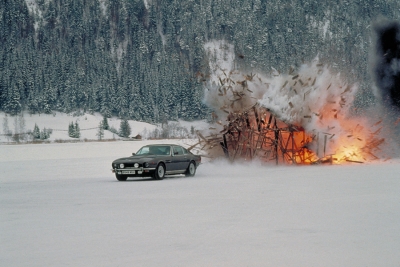
Explosions on screen come in many sizes – from the blowing up of models to the destruction of full sized buildings. The most common in war films are stimulated bombs and shells. Since actors and stunt men are usually involved, it is crucial that the explosions are safely carried out.
According to the British special-effects expert Cliff Richardson: ‘It’s surprising how close you can stand to a hole in the ground with several pounds of gelignite in it, which will blow a ton of earth into the air.’
One of Richardson’s biggest explosive jobs was during the making of The Battle of Britain (1969), when he and his team had to blow up a huge, sturdy aircraft hangar.
‘inside the hangar we had the partition walls knocked down to weaken the structure and this virtually left the roof of the hangar supported on 30 brick piers,’ Richardson said. ‘One hundred and fifty shot holes were drilled into the piers to receive the cartridges of explosives which were all lined together with Cordtex detonating fuse.
‘It was necessary to add a number of extra effects to make the shot spectacular. These included two “fougasse charges”, which are a type of mortar made, in this case, with 50 gallon drums of petrol which can be fired horizontally or vertically. I used one vertically to create a fireball effect through the roof of the hangar.
‘The hangar doors were taped with Cordtex and a mock-up Spitfire was suspended just inside. A horizontal fougasse was then positioned to produce the wall of fire which carried the Spitfire and the shattered doors across the roadways outside.’
In science-fiction movies, effects men are often called upon to blow up entire planets – as in Star Wars and Superman. A model of the planet is hung from the ceiling of a shooting stage and the camera shoots from below. When the charge goes off, the pieces fall towards the camera, creating the illusion of an explosion in space.
Picture Credit : Google

